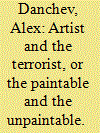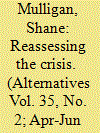| Srl | Item |
| 1 |
ID:
099979


|
|
|
|
|
| Publication |
2010.
|
| Summary/Abstract |
This article is offered as a small demonstration of what art has to say about terror and violence. It focuses on the German artist Gerhard Richter and his cycle of paintings on the life and death of the homegrown terrorists of the Baader-Meinhof group, October 18, 1977 (1988). Following Richter, it explores whether atrocity is "paintable." It investigates the encounter between the artist and the terrorist and proposes that Richter's is a profound exploration of terror and counterterror in the contemporary world.
|
|
|
|
|
|
|
|
|
|
|
|
|
|
|
|
| 2 |
ID:
099983


|
|
|
|
|
| Publication |
2010.
|
| Summary/Abstract |
This article applies a method of conceptual analysis to understand peace processes in a divided society. Through the analysis of the concept of parity of esteem, this article examines some neglected dimensions of conflict studies, including politicizations, contestations and politicking involving key concepts in peace processes and conflict resolution. The analysis focuses specifically on politics in Northern Ireland, but it also seeks to inform a more general understanding of the dynamics of peace processes and conflict reconciliation.
|
|
|
|
|
|
|
|
|
|
|
|
|
|
|
|
| 3 |
ID:
099982


|
|
|
|
|
| Publication |
2010.
|
| Summary/Abstract |
Geopolitics has long been associated with material factors, but theories of international relations continue to evade questions about ecological degradation and declining natural resources. One important point of intersection is the relationship between liberalism and natural abundance/scarcity. There are grounds to suggest that liberal ideas and revolutions owe their emergence and endurance to ecological abundance, particularly in the form of immense stores of solar energy in fossil fuels: such fuels have literally powered the modern liberal project. Some ecological thinkers argue that humanity, or "civilization," is soon to face massive ecological, economic, and social decline as a result of declining resources, but it is difficult to picture just what "collapse" might entail in political terms. This article examines the prospect that what many see as the current decline of liberalism may in fact be a manifestation of ecologically induced collapse, especially due to the limit to growth represented by "peak oil." It concludes with consideration of the merits of a more ecological perspective on our political existence.
|
|
|
|
|
|
|
|
|
|
|
|
|
|
|
|
| 4 |
ID:
099981


|
|
|
|
|
| Publication |
2010.
|
| Summary/Abstract |
Engaging with the literature on visual representations of human suffering, being a witness, and trauma, this article discusses visual representations of the 1994 genocide in Rwanda, and especially the art photography of Alfredo Jaar, Robert Lyons, and Jonathan Torgovnik of the aftermath of the genocide. It explores the conditions in which photography can succeed in disrupting stereotypical political interpretations of the killings. Art photography, it is argued, may help transform the viewers from being consuming spectators into being participant witnesses who self-critically reflect upon their own subject positions in relation to the conditions depicted in the image. By discussing photography of the aftermath of the genocide, the article acknowledges the unrepresentability of genocide; by focusing on visual representations, it reflects the extent to which political space is nowadays constituted by means of images; by concentrating on Rwanda, it contributes to the necessary process of examination and self-examination in connection with the killings.
|
|
|
|
|
|
|
|
|
|
|
|
|
|
|
|